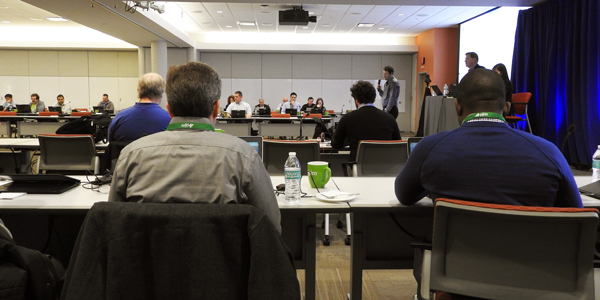VALLEY FORGE, Pa. — PJM stakeholders are questioning the process for how a transmission development proposal will proceed following a debate at last week’s Planning Committee meeting.
The issue arose during a discussion of the effort to incorporate cost containment into transmission project proposals. A series of events at January’s Markets and Reliability Committee meeting culminated in the issue going back to the PC for additional consideration. A PJM proposal was voted down, and the RTO’s Suzanne Daugherty, who chairs the MRC, then determined that an alternate proposal from LS Power, which didn’t receive a vote, would be the main proposal the committee considers when the issue returns.
But a gas-fired generation representative who asked not to be named questioned whether Daugherty had the authority to make that determination. Stakeholders who supported his assessment pointed out that the MRC directed the PC to give the issue additional consideration. The PC could vote on any proposals that come out of that reconsideration to determine the order in which they’re presented at the MRC, they argued.
Other stakeholders, including Calpine’s David “Scarp” Scarpignato, were hesitant to accept that interpretation of the rules, arguing that they had acted at the MRC under the expectation that the appropriate outcome had occurred.
Stakeholders have been considering the issue through special sessions of the PC and working under the belief that LS has control of what the primary proposal will say. Under the MRC’s rules, the committee doesn’t consider alternate proposals if the primary proposal is endorsed. (See PJM Stakeholders Explore Cost Containment Complexities.)
PJM staff agreed to consider the process questions and make a determination, but they also questioned the usefulness of focusing on that rather than trying to find stakeholder consensus.
“This is largely academic,” PJM’s Steve Herling said.
“We can as a group figure out what’s giving everybody the most heartburn and try to work on those” issues, PJM’s Sue Glatz said.
Market Efficiency Charter
Stakeholders endorsed the charter for the Market Efficiency Process Enhancement Task Force (MEPETF), which has been stood up to consider ways to improve the process for developing market efficiency projects. It will analyze seven processes:
- How the benefit-to-cost ratio is calculated;
- How facility service agreements (FSAs) are modeled;
- The process for proposal windows;
- How interregional market efficiency projects (IMEPs) are selected;
- How projects are re-evaluated;
- The process for regional targeted market efficiency projects (TMEPs); and
- The process for updating assumptions about the system in the middle of the proposal cycle.
The group has met three times, with the next meeting planned for April 20.
Reactive Transfer
The RTO plans to revise two of its reactive transfer interface definitions effective June 1, PJM’s Yuri Smolanitsky said. Staff will add the 5059 Breinigsville-Alburtis No. 1 500-kV line to the eastern interface. The new line is expected to be in service by next spring.
Three 345-kV lines — Hanna-Chamberlin, Star-N. Medina and Monroe-Lallendorf — are being added to the Cleveland interface to extend it further south and east. Staff expects “minimal” operational impacts, Smolanitsky said.
“One of the reasons we’re trying to expand the definition [is] so we have more options” to address operational contingencies, PJM’s Aaron Berner explained.
Facility Rating Concerns
Ryan Dolan of American Municipal Power highlighted concerns his organization and the PJM Industrial Customer Coalition have with how transmission owners calculate facility ratings. Dolan said the methodologies used by TOs to file facility ratings in compliance with NERC reliability standard FAC-008-3 aren’t made available to stakeholders, so it’s impossible to independently verify them.
The same issue is at the heart of a ruling made in January by a FERC administrative law judge that PJM’s system impact study (SIS) process is unjust and unreasonable because of a lack of transparency. In that case, merchant transmission developer TranSource brought a complaint that it wasn’t able to accurately assess cost estimates prior to paying significant filing fees for line upgrades it proposed because PJM uses confidential information in the estimates. The RTO vowed to challenge the ruling, and parties in the case have submitted comments. (See FERC Judge Faults PJM, TOs on Transmission Upgrade Process.)
AMP says it wants to discuss better tracking of changes to facility ratings and development of a publicly available ratings database to help stakeholders determine factors that are limiting facilities’ performance.
Order 1000 Filing Catches Up
Staff plan to file for FERC approval later this month process revisions related to Order 1000 that stakeholders endorsed in February 2016, PJM assistant general counsel Pauline Foley said. The revisions will require renewal every three years of transmission developers’ prequalified status to be named the designated entity for a project. They also clarify that the deadline for designated entities to submit their agreement and credit paperwork is 60 days after PJM provides it to them.
The filing was postponed while FERC was without a quorum and ran into unforeseen staff delays subsequent to the quorum returning, Foley said. PJM will be contacting the prequalified entities to update their prequalification status.
Nuclear Deactivations
Staff have begun the analysis of whether the four nuclear plant closures announced by First Energy Solutions in March will create reliability concerns. Calpine’s Scarp said the main question is whether PJM will be offering the units reliability-must-run contracts.
“Really, that’s the only information out of this we’re trying to get,” he said.
Staff said that determination would be based on an analysis that hadn’t been completed yet. FES has requested to deactivate Davis-Besse in the ATSI transmission zone in Ohio by June 1, 2020. Perry, which is also in ATSI, and Unit 1 of the Beaver Valley facility in Duquesne Power and Light’s zone would be deactivated by June 1, 2021, and the second unit by Nov. 1, 2021.
PJM denied are any reliability issues when FES announced the closures on March 29. (See FES Seeks Bankruptcy, DOE Emergency Order.)
— Rory D. Sweeney



